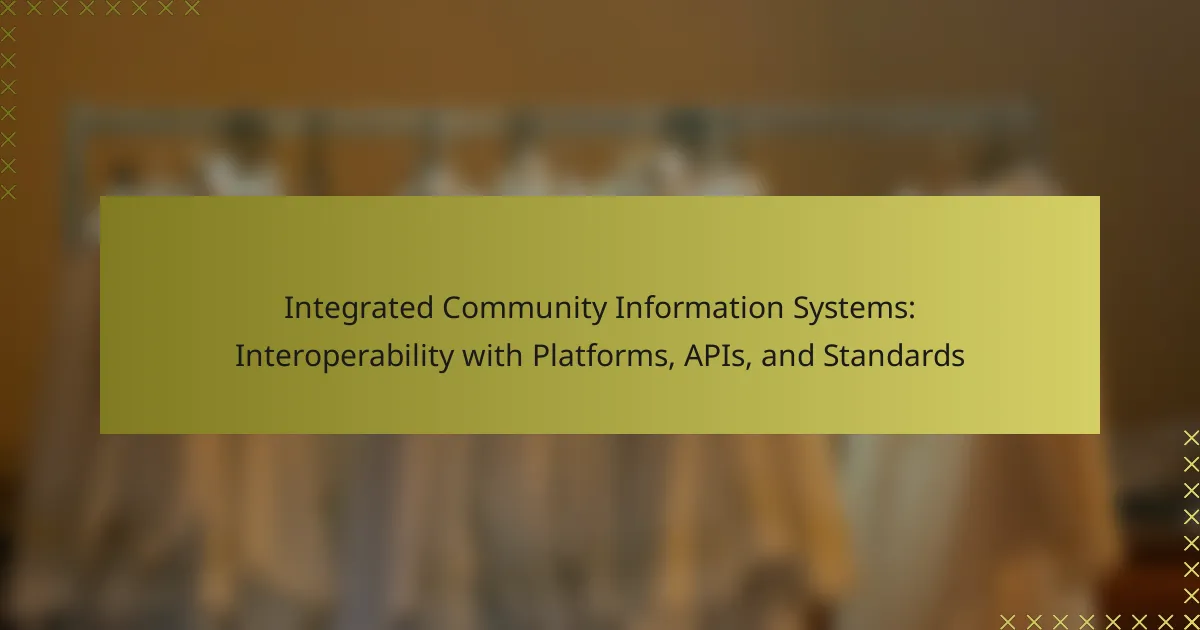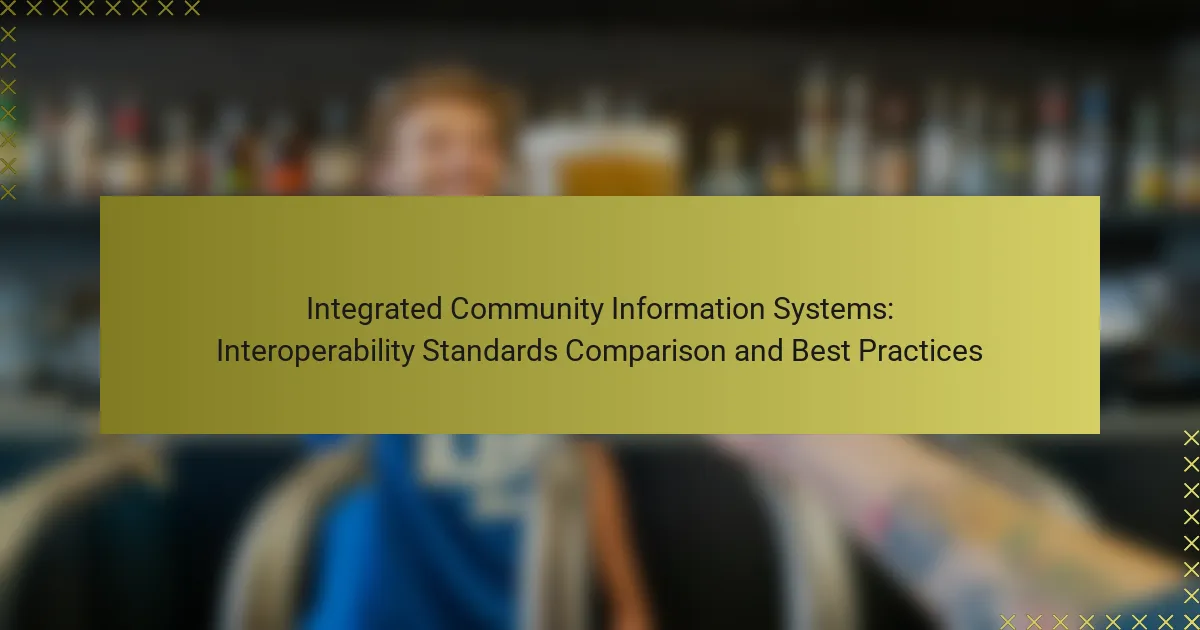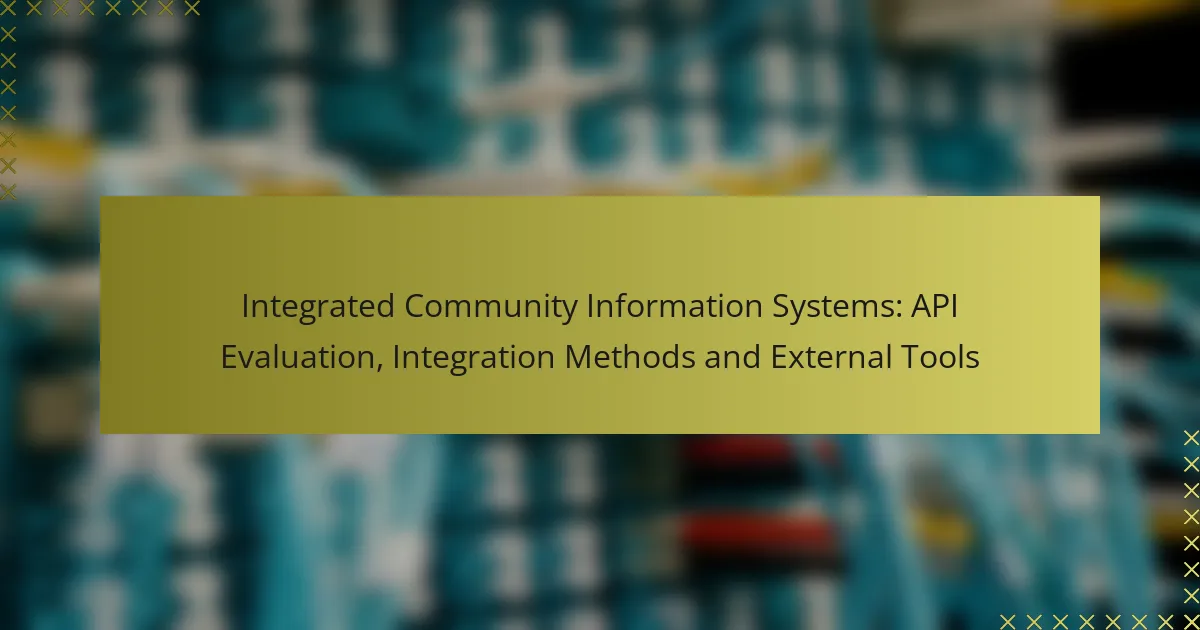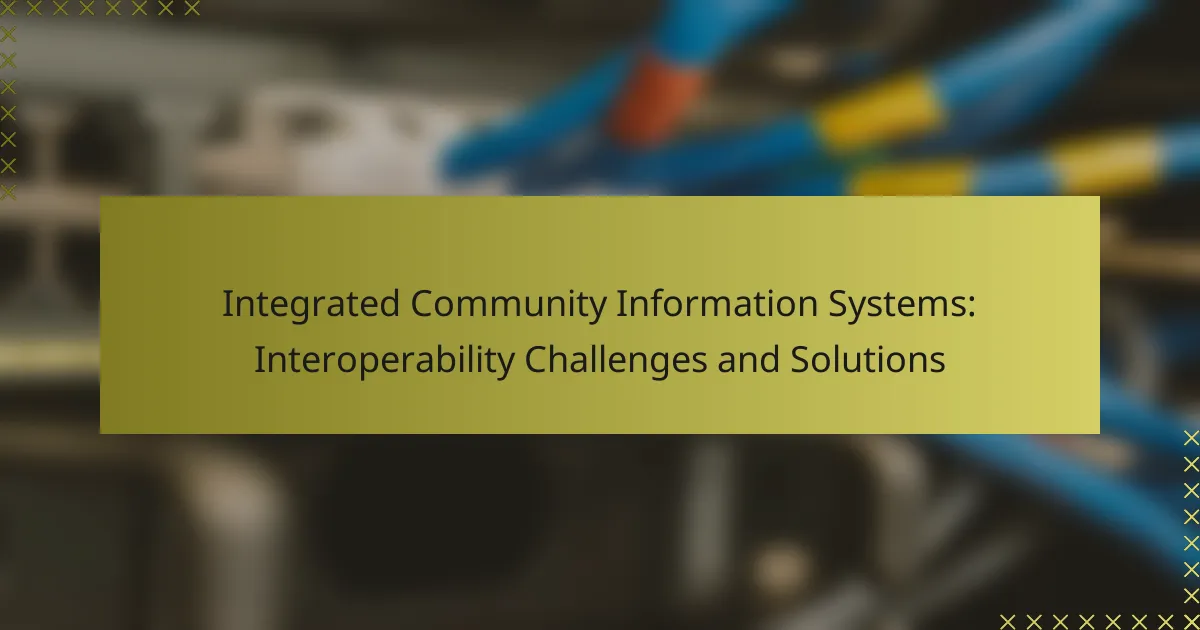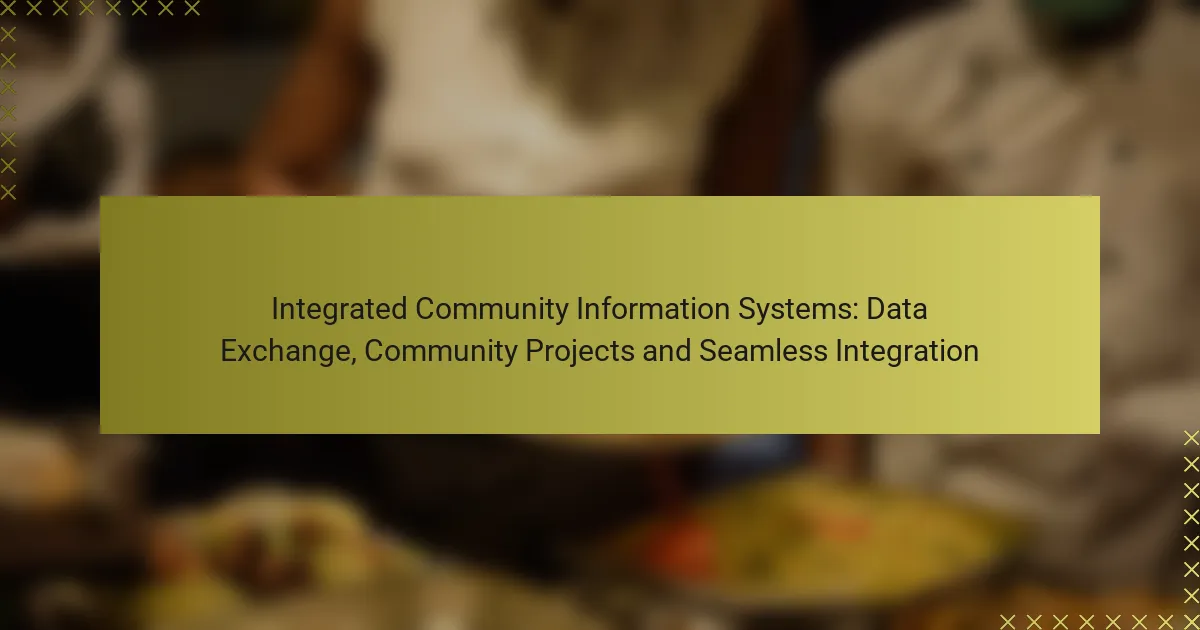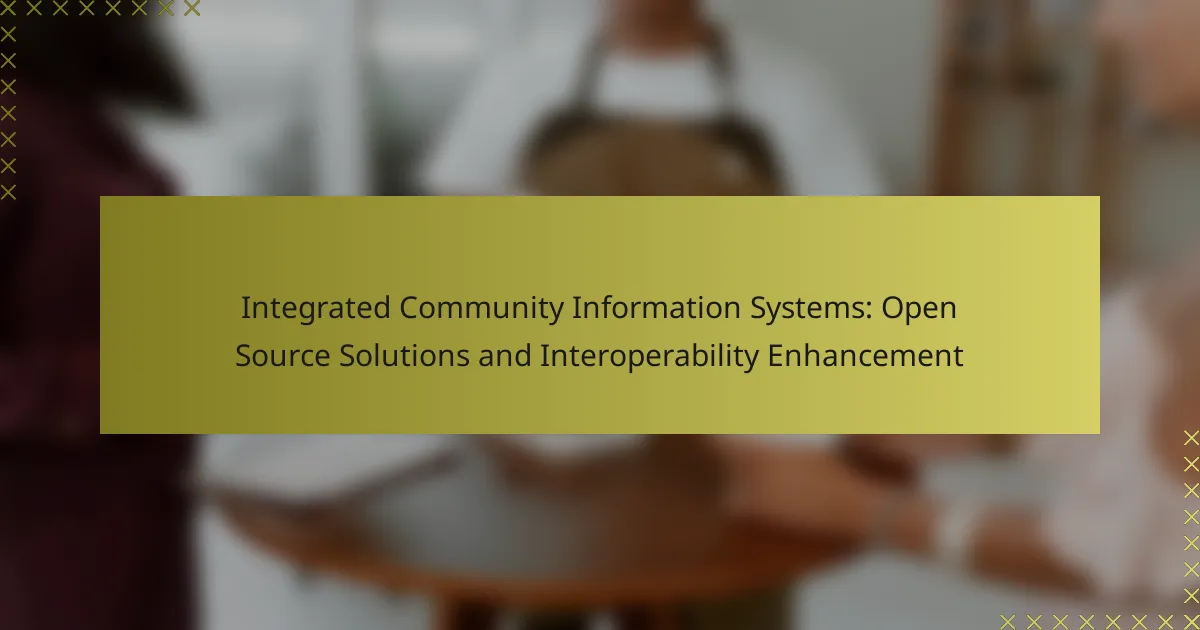What are the interoperability solutions for Integrated Community Information Systems?
Interoperability solutions for Integrated Community Information Systems (ICIS) enable different systems to communicate and share data effectively. These solutions enhance collaboration, streamline processes, and improve service delivery across various community services.
API integrations
API integrations allow different software applications to communicate with each other through defined interfaces. By using APIs, systems can share data in real-time, making it easier for community organizations to access and utilize information from multiple sources.
When implementing API integrations, consider the security of data exchanges and ensure that APIs are well-documented. For instance, using RESTful APIs can simplify the integration process, as they are widely adopted and easy to implement.
Data exchange standards
Data exchange standards define the formats and protocols for data sharing between systems. Common standards include HL7 for healthcare data and ISO 21127 for cultural heritage information, which facilitate consistent data interpretation across different platforms.
Adopting these standards can minimize errors and enhance data quality. Organizations should evaluate which standards are most relevant to their specific needs and ensure compliance to improve interoperability.
Middleware platforms
Middleware platforms serve as intermediaries that connect different applications, enabling them to communicate seamlessly. These platforms can handle data transformation, routing, and protocol conversion, thus simplifying the integration process.
Choosing the right middleware solution depends on the specific requirements of the community systems involved. Popular options include Apache Camel and MuleSoft, which provide robust capabilities for managing complex integrations.
Cloud-based solutions
Cloud-based solutions offer scalable and flexible options for interoperability by hosting applications and data in the cloud. This approach allows for easier access and sharing of information across various community services without the need for extensive on-premises infrastructure.
When considering cloud solutions, assess factors such as data security, compliance with local regulations, and the ability to integrate with existing systems. Providers like AWS and Microsoft Azure offer tools that can enhance interoperability in community information systems.
Interoperability frameworks
Interoperability frameworks provide structured guidelines and best practices for achieving seamless integration between systems. These frameworks often include methodologies for assessing current capabilities and planning future developments.
Examples include the Open Group Architecture Framework (TOGAF) and the Interoperability Maturity Model (IMM). Organizations should adopt a framework that aligns with their strategic goals and fosters collaboration among stakeholders to enhance overall system interoperability.
How do Integrated Community Information Systems connect with existing platforms?
Integrated Community Information Systems (ICIS) connect with existing platforms through various methods that facilitate data exchange and interoperability. These connections ensure that different systems can communicate effectively, allowing for streamlined operations and improved service delivery.
Using RESTful APIs
RESTful APIs are a popular method for connecting Integrated Community Information Systems with other platforms. They allow systems to communicate over the web using standard HTTP methods, making it easy to retrieve and send data in a structured format like JSON or XML.
When implementing RESTful APIs, consider the security of data transmission and the need for authentication mechanisms. Common practices include using OAuth tokens and HTTPS to protect sensitive information during exchanges.
For example, a community health information system might use a RESTful API to pull patient data from a hospital’s electronic health records system, enabling real-time access to vital information.
Implementing HL7 standards
HL7 standards are essential for ensuring that healthcare-related data can be shared seamlessly between Integrated Community Information Systems and other healthcare platforms. These standards provide a framework for the exchange, integration, sharing, and retrieval of electronic health information.
When implementing HL7, organizations should focus on compatibility with existing systems and the specific version of HL7 being used, such as HL7 v2.x or HL7 FHIR. Understanding the nuances of these standards can help avoid common integration pitfalls.
For instance, a community health organization may adopt HL7 FHIR to facilitate the exchange of patient records with local hospitals, improving care coordination and reducing duplication of services.
What are the benefits of interoperability in community information systems?
Interoperability in community information systems allows different platforms to communicate and share data seamlessly, enhancing overall functionality. This leads to improved collaboration among various stakeholders, ultimately benefiting the community through better access to information and services.
Improved data sharing
Improved data sharing is a key benefit of interoperability, enabling organizations to exchange information efficiently. For instance, when health services and social services can access the same client data, they can coordinate care more effectively, reducing duplication of efforts.
To facilitate data sharing, organizations should adopt common data standards and protocols. This ensures that information is formatted consistently, making it easier to integrate systems and share relevant data across different platforms.
Enhanced service delivery
Enhanced service delivery occurs when interoperability allows for a more holistic view of community needs. For example, a community center that integrates data from various service providers can identify gaps in service and respond more quickly to emerging issues.
To maximize service delivery, organizations should prioritize user-friendly interfaces and real-time data access. This enables service providers to make informed decisions quickly, improving response times and overall service quality.
Increased efficiency
Increased efficiency is achieved through streamlined processes and reduced administrative burdens. When systems are interoperable, staff spend less time on data entry and more time on direct service provision, leading to better outcomes for the community.
Organizations can implement automation tools to further enhance efficiency. For example, automated data transfers between systems can minimize manual errors and ensure that all stakeholders have access to the most current information without delays.
What challenges do Integrated Community Information Systems face in achieving interoperability?
Integrated Community Information Systems often struggle with interoperability due to various technical and organizational challenges. These obstacles can hinder data sharing and collaboration across different platforms and systems.
Data silos
Data silos occur when information is isolated within specific departments or systems, preventing seamless access and sharing. This fragmentation can lead to inefficiencies, as stakeholders may not have the complete picture needed for informed decision-making.
To mitigate data silos, organizations should prioritize establishing centralized data repositories or using middleware solutions that facilitate data exchange. Regular audits of data access and sharing practices can also help identify and eliminate silos.
Legacy system limitations
Legacy systems often lack the flexibility and compatibility needed for modern interoperability. These outdated technologies may not support current data standards or protocols, making integration with newer systems challenging.
Organizations should assess their legacy systems and consider phased upgrades or replacements. Implementing APIs (Application Programming Interfaces) can also help bridge the gap between old and new systems, allowing for better data flow.
Compliance issues
Compliance with regulations and standards can pose significant challenges for interoperability in Integrated Community Information Systems. Different jurisdictions may have varying requirements regarding data privacy and security, complicating data sharing efforts.
To address compliance issues, organizations should stay informed about relevant regulations, such as GDPR in Europe or HIPAA in the United States. Regular training for staff on compliance matters and establishing clear data governance policies can help ensure adherence to these requirements while promoting interoperability.
What criteria should be considered when selecting interoperability solutions?
When selecting interoperability solutions for integrated community information systems, key criteria include scalability, cost-effectiveness, and vendor support. These factors ensure that the chosen solution can grow with the organization, remain within budget, and provide reliable assistance when needed.
Scalability
Scalability refers to the ability of an interoperability solution to handle increasing amounts of data and user demand without compromising performance. It’s crucial to choose a system that can expand as your community’s needs evolve, whether that means accommodating more users or integrating additional data sources.
Consider solutions that offer modular architecture, allowing you to add features or capacity as required. For example, a cloud-based system may provide the flexibility to scale up resources during peak times without significant upfront investment.
Cost-effectiveness
Cost-effectiveness involves evaluating the total cost of ownership, including initial setup, ongoing maintenance, and potential upgrade expenses. Look for solutions that provide a clear return on investment by improving efficiency or reducing operational costs.
When assessing cost, consider both direct costs and indirect benefits, such as time saved through automation. A solution that initially appears more expensive may ultimately save money if it significantly reduces manual processes or enhances service delivery.
Vendor support
Vendor support is critical for ensuring the successful implementation and ongoing operation of interoperability solutions. A vendor that offers robust support can help resolve issues quickly, minimizing downtime and disruptions.
Evaluate the vendor’s reputation for customer service, including response times and the availability of training resources. Consider asking for references or case studies from similar organizations to gauge the level of support you can expect.
